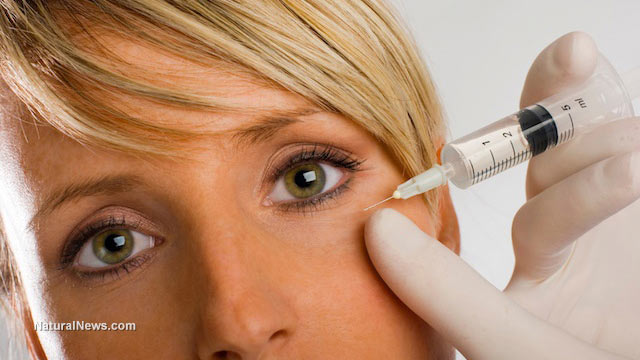Botox for migraines? Here are a few alternatives to consider
Tuesday, May 20, 2014 by: Aurora Geib
Tags: botox, migraines, alternative treatments

- Newly released JFK files reveal Pentagon's role in creating Lyme disease and covid in the same lab
- Ginseng's hidden anti-aging power: How compound K is rewriting the rules of skincare
- “Endgame: The Hidden Agenda 21” unveils a world of conspiracy and control
- L.A.'s rebuilding nightmare: Only 4 permits issued after fire destroys 6,000 homes
- Scientists demand FDA withdraw mRNA COVID vaccines amid contamination and gene therapy concerns
- Dr. Suzanne Humphries makes bombshell appearance on Joe Rogan podcast, exposing vaccine industry deception back to POLIOMYELITIS
- Former Congresswoman exposes CCP's deep infiltration of California through universities, ports, and fentanyl
- “The shame of Minnesota”: Somali immigrants behind $250 million child nutrition fraud in largest COVID-era scam
- PROCESSED TABLE SALT in foods found to fuel depression
- “Independent” anti-Russia outlet MEDUZA faces COLLAPSE as US funding dries up
- Here are TEN all-natural ways to protect your garden without using harmful chemicals
- BPA: The hidden hormone disruptor sabotaging your health - and how to fight back
- Chewing gum's dirty secret: How your daily habit could be flooding your body with microplastics
- The hidden battle in your glass: How A1 and A2 milk could shape your health
- Discovery of vast underground city beneath Giza pyramids challenges human history
- Catastrophic 7.7 earthquake devastates Myanmar and Thailand; death toll could reach 100,000
- CDC finally halts $11 billion COVID funding scam as health officials admit the ‘pandemic’ was a fraud
- Black cumin seed oil emerges as a powerful ally against breast cancer and chronic inflammation
- Newly released JFK files reveal Pentagon's role in creating Lyme disease and covid in the same lab
- Analysis: The coming economic collapse, a mass uprising and Trump's three secret weapons to halt the growing revolt
- Festive flavors: The sweet history, nutritional profile and health benefits of pecan pie
- Elon Musk: Aliens could be here on Earth RIGHT NOW
- Trump reverses course on Gaza plan, says “nobody is expelling Palestinians”
- Big Pharma's $8 Billion bribery scheme exposed: how doctors are pushed to prescribe junk science, not heal
- Boys are back in town: Trump’s patriotic alpha crew takes the wheel while toxic females ride in the backseat
- Reclaim your health: How midlife exercise reverses years of inactivity
- A lack of integrity in Academia: Harvard professor found GUILTY of fraudulent research to promote CRT theory
- Survival 101: Effective EMF blocking techniques
- EPA advisor admits the agency is funneling billions to climate groups ahead of Trump’s return to White House
- Dr. Mike Yeadon releases 15-minute testimony - WATCH - about genocidal intent of COVID “vaccines”
- 5 Simple steps to boost your brainpower: How to strengthen executive function in a distracted world
- Florida takes a stand: DeSantis proposes permanent ban on mRNA vaccine mandates
- Sugarcane extract superior to cholesterol-lowering drugs?
- Mike Adams Sermon 66: God will DESTROY ISRAEL for its wickedness
- Pilots report mysterious lights 'moving at extreme speeds' across Oregon skies
- Space war brewing? Russia threatens to destroy Starlink satellites
- EPA advisor admits the agency is funneling billions to climate groups ahead of Trump’s return to White House
- California's social media censorship law struck down: A victory for free speech or a threat to online safety?
- The Health Ranger releases “Vaccine Zombie” song and music video, using AI-animated zombies for the music video
- Dr. Mike Yeadon releases 15-minute testimony - WATCH - about genocidal intent of COVID “vaccines”
- The pandemic as a tool for INDOCTRINATION: Understanding “The Indoctrinated Brain” by Dr. Michael Nehls
- Newly released JFK files reveal Pentagon's role in creating Lyme disease and covid in the same lab
- Florida takes a stand: DeSantis proposes permanent ban on mRNA vaccine mandates
- Mike Adams releases country western hit single: Goin’ Back in Time is Comin’ Home
- Mike Adams releases music poetry sensation: A Child of God
- “Why we influenced the 2020 elections”: Facebook files reveal the coordinated effort to bury the Hunter Biden laptop story
- Unpacking the Lies That We’ve Been Fed – new song and music video released by Mike Adams, the Health Ranger
- RFK Jr. clears key hurdle: Sen. Susan Collins backs controversial HHS nominee, signaling a new era for health policy
- Mike Adams releases new song and music video: Nothing More Disgusting Than a Globalist
- Michigan sheriff announces criminal investigation into 2020 election crimes, Dominion Voting Systems
- Israeli soldiers accused of even more torture and abuse in the West Bank
- Migrants are taking advantage of recent hurricanes to scam residents and loot their homes
- House Intelligence Committee calls for the ARREST and PROSECUTION of Dr. Anthony Fauci
- Rep. Nancy Mace introduces bill to ban biological males from female facilities on federal property
- Red Cross issues warning to stop blood plasma donations from vaccinated people
- Scientists confirm: GENIUS brain function can be spontaneously unleashed in humans without any apparent cause
- EPA advisor admits the agency is funneling billions to climate groups ahead of Trump’s return to White House
- HYSSOP: What research reveals about the health benefits of this ancient holy herb
- Two containers with completed ballots fall out of truck in Florida
- Fully vaccinated about to see “tsunami” of illness and death, warns virologist
- Global leaders unite to clamp down on “misinformation” with UN-backed Cascais Declaration
- BREAKING: 2025 NDAA authorizes mandatory military draft of WOMEN across America… as Pentagon pursues global NUCLEAR war with both Russia and China at the same time
- Michael Yon warns of a ZIONIST TAKEOVER in Trump’s second administration
- BOMBSHELL: DNA testing kits are a SCAM to develop ethnic-specific bioweapons
- Ozempic and Wegovy weight loss drugs are injectable LIZARD VENOM PEPTIDES that may unleash a devastating wave of organ failure… side effects align with symptoms of SNAKE BITES
- Israeli soldiers accused of even more torture and abuse in the West Bank
- These 13 countries just signed an agreement to engineer a global FAMINE by destroying food supply
- NASA admits that climate change occurs because of changes in Earth’s solar orbit, and NOT because of SUVs and fossil fuels
- RFK Jr. clears key hurdle: Sen. Susan Collins backs controversial HHS nominee, signaling a new era for health policy
- Sermon 30: How Jesus reveals Caesar’s FAKE CURRENCY and FALSE AUTHORITY
- Coriander seeds: Ancient medicine backed by modern science
- Arizona officials claim Maricopa County needs 10-13 days to tabulate results of the election
This finding does not appear to have convinced experts on the efficacy of such procedure. Jen Olesen, Chief of the Danish Headache Centre, Glostrup University Hospital in Denmark, criticizes the findings and identified faults in the trial. He has expressed his concerns to the Lancet which was contained in an editorial of the journal Drug and Therapeutics Bulletin.
Olesen is of the opinion that the FDA made a mistake in approving the botox treatment for migraine. According to him, half of the trial participants overused pain medications, preventing the researchers from telling whether the participants had chronic migraine or headache caused by medication overuse. Moreover, it's impossible to hide participants receiving botox treatments, invalidating the double blind nature of the experiment, as their facial expression change.
Can Botox genuinely do the job?
Botox is a popular drug used for anti-aging treatments. How it came to be considered as a remedy for migraine started ten years ago when some plastic surgeons from Hollywood noticed that their patients felt some relief from migraines after undergoing botox treatment. The idea spread and became an "off-label-treatment" to other practitioners. The pharmaceutical company that developed botox soon found out and started marketing it as a remedy for migraine. The company was subsequently fined for $375 million for unlawful marketing since at that time, there was no proof that botox could indeed treat migraines.Nevertheless, it appears that some studies are beginning to crop up supporting botox as a possible treatment for migraines. According to a recent article featured in the Journal of the American Medical Association, a review and analysis of previous studies on botox injections as a remedy for migraine only reveals a "small to modest benefit for patients suffering chronic migraine headaches and chronic daily headaches."
Headache vs. migraine?
Migraines and tension type headaches are common, and at some point in their life, at least 42 percent of adults experience a tension type headache. Most, however, do not seek professional help, just preferring to take an aspirin and hope that it goes away. Less common, migraines are associated with greater disability affecting around 8 to 18 percent of people worldwide.A headache normally starts with a feeling of gradual pressure or tightness in the head and then increases into a feeling of a tremendous amount of pressure. A common feature of headaches is that they is felt on both sides of the head.Migraines, on the other hand, are normally felt on one side of the head.
Fatigue or lack of sleep, emotional stress and depression have all been identified to be leading causes of headaches. Certain foods have also been identified to have a potentially contributing factor.
Dealing with the headache
For many people, the onset of a headache means downing a pill. Contrary to popular belief, however, the answer is not always drugs: Drugs only build up dependency and do not in any way address the real source of the matter. Below are some options to dealing with those pesky headaches:Visit a chiropractor - In a study published in the Journal of Manipulative and Physiological Therapeutics, 218 study subjects suffering from headache who were given either chiropractic care or drug therapy or both experienced a 40 to 50 percent reduction in pain. However, four weeks after all care ended, those who had chiropractic care still enjoyed the benefit of their relief as opposed to those who received drug therapy who experienced only a 50 percent reduction in their improvement.
In a study conducted by Duke University comparing drug therapy using amitriptyline with that of chiropractic care, both treatments had similar short term effects on tension headache pain. Amitriptyline, however, caused adverse reactions in 82 percent of the study subjects. The best part of this study occurred when all care was discontinued, patients who had received drug therapy returned to the state they had prior to the research study, but those who received chiropractic care continued to benefit from reduction in headache frequency and severity.
Acupuncture - This is an ancient Chinese healing method that stimulates specific points in the body using thin metallic needles. The British Journal of Medicine published a study which involved 400 adult subjects who experienced regular headaches or migraines. They were divided into groups: one received only standard conventional care while the other group received 12 acupuncture sessions for a three month period.
At the conclusion of the said study, it was revealed that compared to those who were on conventional care, participants who received acupuncture sessions experienced more or less fewer overall headaches and used less medication. This group also reported taking only a few sick days off from work.
Try herbal remedies - History has shown how herbs have been used for food and medicine. Using herbs instead of downing a common prescription drug for pain has its advantages since herbs do not normally have the unwanted side effects of prescription drugs. Moreover, their continued use over the centuries has proven its safety for human consumption.
Nevertheless, even though herbs have no or little undesirable side effects, they can cause some undesirable reactions in some persons. It is recommended, therefore, to try one herb at a time beginning with small doses and watching out for side effects.
In Traditional Chinese Medicine, ginger is highly recommended for dealing with headaches: you can either eat it fresh or enjoy it as tea. You can also enjoy herbal teas like chamomile, peppermint or rosehip to deal with a tension headache.
In India, betel leaf is used to relieve intense headaches. Containing analgesic and cooling properties, it can be applied over the affected area with beneficial results.
A few drops of Lavender essential oils can be used to massage the temple, relaxing the muscles and relieving pain.
Try changing your diet - Avoid products that contain aspartame and MSG. These products have been known to trigger headaches, and 75 percent of reported adverse reactions to food additives are attributed to aspartame. Food additives like nitrates and nitrites found in processed food dilate blood vessels triggering headaches in some people sensitive to it.
Try a massage - In a recent study published in the online journal Annals of Behavioral Medicine, it was revealed that massage therapy could be a nonpharmacologic treatment for migraine. In the said study, migraine sufferers were randomly assigned to massage or control conditions. The study concluded revealing massage participants exhibiting exceptional improvements in the frequency of migraine attacks as well as quality of sleep during the period of intervention and the follow-up which was conducted three weeks later.
Moreover, an observation regarding a trend on the beneficial effects of massage was found. This was especially true as regards the individual participant's perceived stress and coping efficacy. During sessions, massage produced a decrease in state anxiety, heart rate and cortisol.
Exercise- According to an article on NaturalNews.com, people who don't exercise are 14 percent more likely to experience headaches.
A recent study in Sweden investigated the connection between exercise and its effects on headache. It involved 26 participants taking part in a 40 minute cycling exercise program conducted indoors, thrice a week for twelve weeks. The researchers monitored each participant's use of oxygen to measure the fitness level. The participants, for their part, recorded their migraine attacks during the said study. They also noted the days in which the migraines occurred, how intense they were and how much medication was used.
At the conclusion of the study, participants were reporting less migraine attacks occurring less often and with less intensity. It was observed that maximum oxygen uptake noticeable increased.
Can we prevent migraines from happening?
They say that prevention is better than cure, but does it apply to migraines as well? Research has revealed that migraines occur for a reason and are normally caused by triggers. These are factors, whether external or internal, that set a migraine in motion. Weather, food, changes in the daily schedule or hormonal changes have been identified as some of the triggers that could cause a migraine.For those who suffer from migraines, keeping a diary of migraine attacks could be an effective way of identifying your trigger. According to relieve-migraine-headache.com, the key to finding your trigger is taking stock of your activities 1-2 days before a migraine attack and finding out what's in common. It can be along process, but it is worth the effort. Identifying what can trigger a migraine is the best way of keeping it from affecting your quality of life.
Sources for this article:
http://www.newscientist.com
http://jama.ama-assn.org/content/307/16/1736
http://www.choosenatural.com/headaches/
http://www.naturalnews.com
http://my.clevelandclinic.org
http://www.relieve-migraine-headache.com/migraine-prevention.html
Herbs:
Bakhru, H.K.(2008) Herbs That Heal: Natural Remedies for Good Health. India: Orient Paperbacks
Lavender oil:
Freeman, J. and Raven P. (2007) Herbal Therapeutics. Retrieved from http://www.google.com.ph/
Massage:
Lawler P.S. and Cameron L.D.(2006) A randomized controlled trial of massage therapy as a treatment for migraine. Annals of Behavioral Medicine.32 (1) 50-59, DOI: 10.1207/s15324796abm3201_6
Botox at FETCH.news
Get independent news alerts on natural cures, food lab tests, cannabis medicine, science, robotics, drones, privacy and more.
Take Action: Support Natural News by linking to this article from your website
Permalink to this article:
Embed article link: (copy HTML code below):
Reprinting this article:
Non-commercial use OK, cite NaturalNews.com with clickable link.
Follow Natural News on Facebook, Twitter, Google Plus, and Pinterest
Science News & Studies
Medicine News and Information
Food News & Studies
Health News & Studies
Herbs News & Information
Pollution News & Studies
Cancer News & Studies
Climate News & Studies
Survival News & Information
Gear News & Information
News covering technology, stocks, hackers, and more



"Big Tech and mainstream media are constantly trying to silence the independent voices that dare to bring you the truth about toxic food ingredients, dangerous medications and the failed, fraudulent science of the profit-driven medical establishment.
Email is one of the best ways to make sure you stay informed, without the censorship of the tech giants (Google, Apple, Facebook, Twitter, YouTube, etc.). Stay informed and you'll even likely learn information that may help save your own life."
–The Health Ranger, Mike Adams













































